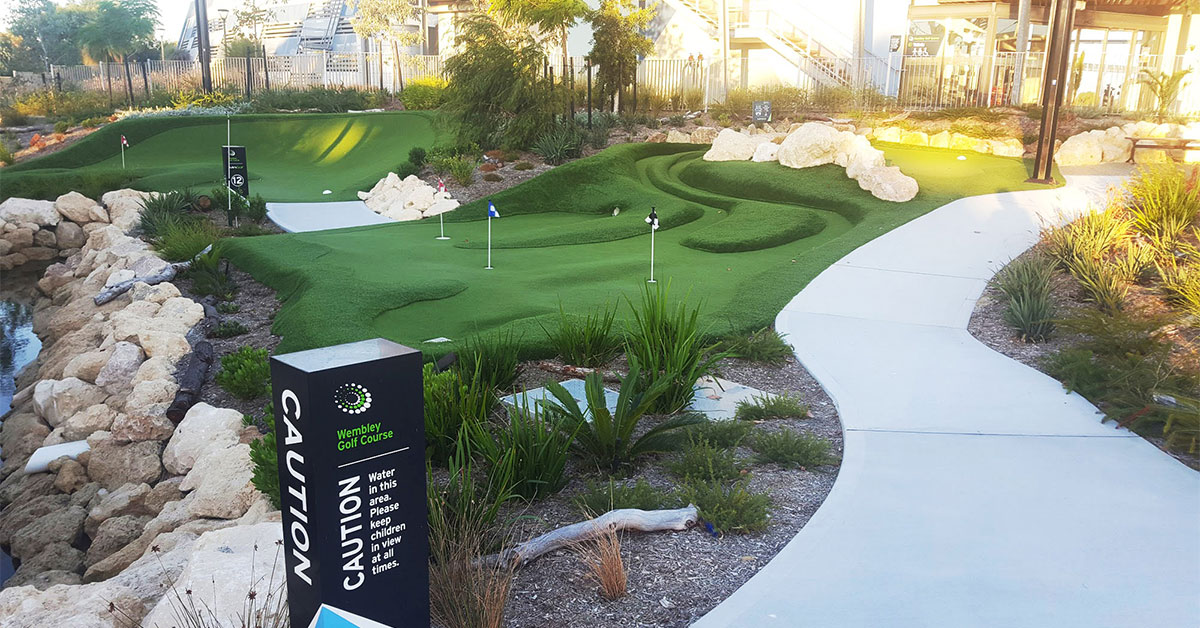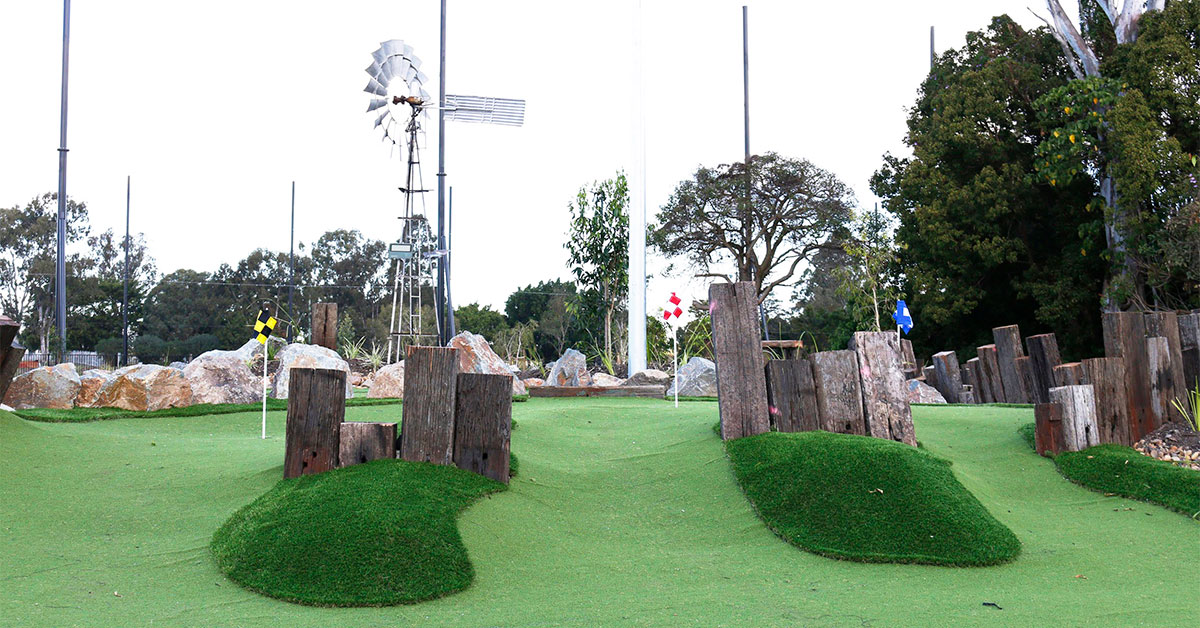The rise in – and importance of – mini-golf courses.
Believe it nor not, there is artistry in concrete when it comes to golf. Mention concrete to most golfers and their mind turns to ugly cartpaths – or another visually undesirable element of a golf course – yet these days the ‘grey matter’ is becoming more prevalent. And that’s a good thing.
Golf-course architecture is a niche enterprise and mini-golf is a niche within that niche. And Gold Coast-based course architect Richard Chamberlain has carved out his own in somewhat unexpected fashion.

After venturing out on his own in 2008 after a stint spent working for Ross Watson, Chamberlain redesigned individual holes or green complexes at various courses but landed nothing that could be described as a major design project. Then the opportunity to design his first mini-golf layout at Perth’s Wembley Golf Course materialised by chance when Wembley’s former general manager, Matt Day, told Chamberlain: “Work out how to build a mini-golf course because we’re putting one in.”
“And you wouldn’t think it would be that much different, but my head exploded,” Chamberlain says of the intricacies required.
And about that concrete?
 “It’s not like shaping a golf course – once that concrete’s down, it’s down. You can’t change it,” Chamberlain says, adding that he and business partner Geoff Bennell use the same Perth-based company, Royale Concrete Solutions, for all projects. “They would take two to three hours to concrete one hole. It’s mostly boring to watch, but they could be 1 or 2 percent off or some shape’s not quite right and you’ve got to be right on it.
“It’s not like shaping a golf course – once that concrete’s down, it’s down. You can’t change it,” Chamberlain says, adding that he and business partner Geoff Bennell use the same Perth-based company, Royale Concrete Solutions, for all projects. “They would take two to three hours to concrete one hole. It’s mostly boring to watch, but they could be 1 or 2 percent off or some shape’s not quite right and you’ve got to be right on it.
“We made a rule when we’re concreting that we don’t take phone calls because you turn your back for 10 minutes and the concrete’s down and concreters don’t really like going back and re-doing things. The concreting is the most stressful part of it even through you’re mostly bored, mixed in with three or four moments of terror. It’s usually a team of five and it’s like a choreographed dance. They all know each other’s movements perfectly.”
Chamberlain now has seven mini-golf courses to his credit, spread across Australia. There are two in Perth – at Wembley and The Vines Resort – plus KDV Sport on the Gold Coast, City Golf Club in Toowoomba, Curlewis Golf Club on Victoria’s Bellarine Peninsula, a nine-holer at Rich River on the Murray River and most recently at Maroochy River Golf Club on Queensland’s Sunshine Coast. More projects are in the wings, including at Moore Park Golf Club in the heart of Sydney’s CBD, while even top-tier private clubs are curious. Chamberlain has fielded enquiries from at least two top 50-ranked clubs seeking outside-the-box ideas for their membership.
The 54-year-old has almost single-handedly dragged mini-golf design into a new and more sophisticated era. Count your columnist among those golfers whose early memories of putt-putt and mini-golf courses constitute rudimentary and unsubtle features such as ramps, blocks and unforgiving edges that required the ball to be moved a putterhead’s span away in order to strike the next shot. After that came the clowns-and-windmills phase. The art has definitely evolved since then.
While a market remains for them, Chamberlain says the more elementary designs are prone to losing their drawing power after a few years. And if you think a more polished mini-golf course equates to higher construction costs, you’re right. However, Chamberlain says most facilities he’s worked with are breaking even on their investment after just two to two-and-a-half years, the mini-golf often generating more revenue than the main course and with far less maintenance.

Still, it has been a learning process. After evaluating the next-level designs of their main competitor, Chamberlain and Bennell quickly realised mini-golf had graduated beyond clowns and windmills. They reasoned that the notion of risk and reward now needed to be duplicated from ‘big’ golf courses to their little ones.
“I knew we had to implement a risk-and-reward philosophy, where we give golfers a little temptation but we don’t want to put them into the garden all the time,” Chamberlain recalls.
Less glamorous but equally important in the process is drainage. Coming from – as he puts it – the “Ross Watson School Of Design”, Chamberlain has learned the value of knowing where water will gather and flow. “He really drilled the engineering and the drainage into you, and all I’ve done is make sure of that. Guys still build holes where they don’t put any drainage under the actual cup itself and it fills up with water. I’m constantly trying to work out where I want to shed the water in a storm event, but the tricky part is: where the water wants to go is generally where the golf balls want to go.”
Adding drainage right under the cups was what Chamberlain calls their “quantum breakthrough”. Instead of a convex shape where the water sheds away from the hole, they captured it, so as the water’s going towards the cup so is the golf ball. It’s been an eye-opener for Chamberlain and Bennell, with each lesson – large and small – put in place with every new project.
“All the little one-percenters that we’ve learned over the past seven projects are worth their weight in gold just with regard to: how to get the players around faster, how hard to make the golf holes – I’ve certainly learned that I’m backing them off in difficulty a little bit – and little things like the grass gets quicker as it wears.

“I think we really nailed Maroochy from a difficulty point of view. I’ve been up there two or three times to play it and when you can hear all the kids and families getting holes-in-one and they’re ya-hooing, I’m thinking, It’s like golf: we’ve got to stop making these things too hard! We’ve got to make it fun – and if the course is a little bit too easy, who cares? They’re having more fun.”
The ultimate solution comes at Wembley, where there are courses within each course. Chamberlain’s design there provides three cups of varying diameters on every hole, positioned to increase the difficulty of the challenge. Maroochy River’s course features two cups per hole.
“They’re still charging only $15 for a game but it gives the club the option to say, ‘You played to the red flag – give us another $5, go around again and play to the other flag,’ and hopefully you get $20 out of them and they’ve got two hours of entertainment,” Chamberlain says.
Big ideas, little golf holes. Sounds like a concept whose time has certainly come.




